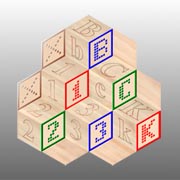![]()
Class 4
Where is all my Stuff on a Computer?
Review
The following photo of a simple game application shows the normal properties of a window including: Title bar, Menu bar, Status bar and the application Workspace. Everything in the workspace is controlled by the application. YOU make changes via the Menu bar (and Tool bars,if any, in the workspace) to modify how the application behaves.
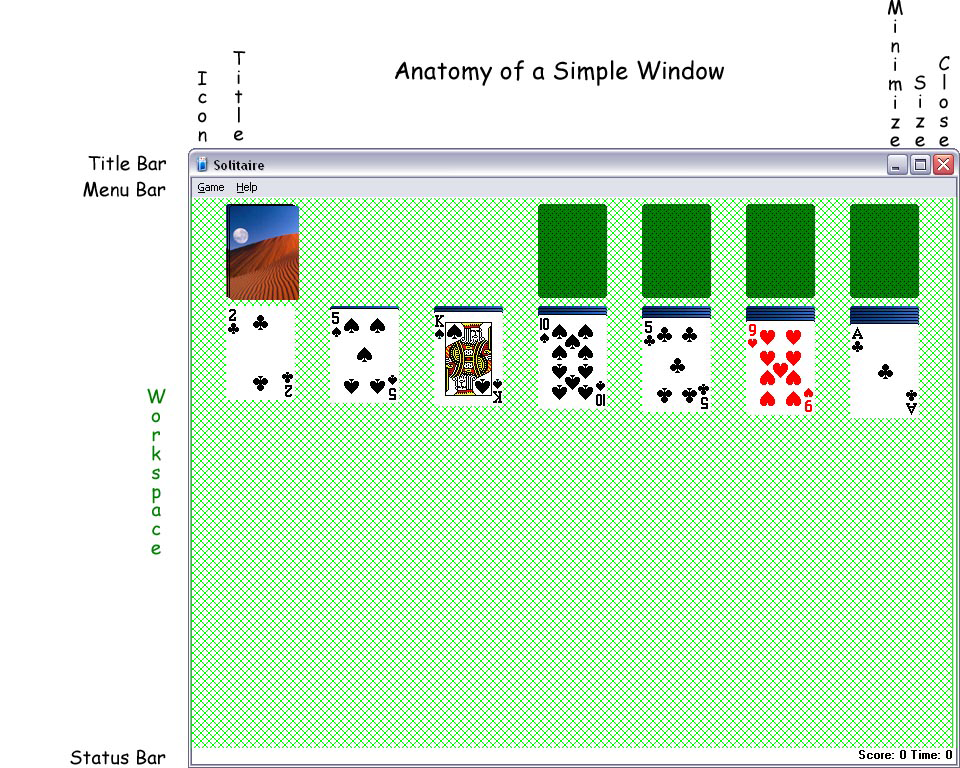
If you did NOT study Class 3, please do so now. You need to know this stuff to go on!
The Class Synopsis follows this paragraph. You should notice that individual sections of this class are colored and underlined, indicating that they are LINKS to the appropriate sections. You may click or touch individual sections to jump to them, or simply scroll down (turn the mouse wheel, if it has one) to the section you wish to continue with.
- How a computer stores your data
- Definition of a Byte (in human terms)
- Parts of a Desktop/Tower Personal Computer
- Role of the Operating System
- Using Windows File Explorer, a file manager
- Windows File Explorer functions
1) How a computer stores your data
![]()
EVERYTHING stored in a computer is stored as a file. We humans are used to many different definitions for a file, but a computer file is not one of them.
When we talk about filing a document or a photograph, it usually means we are putting them away in some sort of Storage Container. We may save a photograph in a shoe box or an album. A document we may put in a file folder which, in turn, goes into a file box or file cabinet, etc. All this means is; we humans think of the process of filing as a way to put an item into a container that makes finding the item later much easier.
To a human, a container is anything we can store something in. Think about all the containers you have made use of over time. Cigar boxes, shoe boxes, canister sets on your kitchen counter, kitchen cabinet drawers, any old empty bottle or can, the list goes on… Many times, the item we want to store defines what we can store it in. For instance: would you pour drinking water into a cardboard shoe box to take on a hike?
With computers, life is much simpler. There is only ONE thing that needs to be stored; a file. What say? Your computer holds many more things than that? Sure: music, videos, photos, documents, etc. But how did you get all that stuff on the computer in the first place? Someone had to CONVERT all the stuff to DIGITAL equivalents.
The resulting digital version of what you choose to save using a computer, is saved in the form of a file. THAT is what we mean by this digital world. When you type up Grandma’s recipe, or scan a photo, or import music…you are converting them to digital…a file! That file can be stored on the computer, copied to other computers on a network, attached to an email, and physically carried somewhere else if you save it on a portable memory (ie: the old floppy disc, a CD or DVD, or the current replacement for the old floppy disc: a flash drive).
Ok, so when we use a computer, we convert everything to a file. What do we store the file in?
Good question. The simple answer is: we put files in folders! That makes the folder a container for files.
At home or work we humans file documents, photos, etc., in different kinds of containers. Documents we usually will save in a file folder. If we have more than one folder, we may put the folders in a file box, or file drawer. Furthermore; sometimes we may shove a folder into another folder, or, maybe, a photograph into a folder with a different document. The one thing we usually don’t think about is: putting something like music or a video into a folder.
So a better question than “What do we store the file in?” would be: “What do we store the folder in?”. The hard drive (or Solid State Drive - SSD) is the computer’s permanent memory. So, we store folders and files on the computer’s hard drive, an external hard drive, or any other memory device we can plug into a port on the computer. That makes a memory device the equivalent of the file box or file drawer we humans use. When we talk about an operating system's file manager (the Windows 10 file manager is Windows File Explorer), we will discuss how we manage files and folders.
NOTE: A memory device is a form of memory AND the support hardware to read and write the data. For instance, a CD is a memory, but neither the computer or a human can 'read' the data on the CD. Reading a CD/DVD requires special hardware. For a human, we listen to music, or watch a movie using a CD or DVD 'player'. The computer reads data from, and usually is able to write data to a CD or DVD using a CD/DVD 'drive'. We will discuss such a 'drive' when we discuss computer hardware.
2) Definition of BYTE
![]()
One of the current 'buzz' words everyone has heard is byte. A 60 kilobyte photograph (60,000), 4 gigabytes of RAM (4 followed by 9 zeros!), a one terabyte hard drive (1 followed by 12 zeros!), etc. In our digital world a byte is the smallest identifiable piece of usable information. If you start thinking about the smallest identifiable piece of a document, you are thinking about a single character!
My classic example: a single letter sized page, with 50 lines of 80 characters. That would take a total storage of 50 x 80 = 4,000 characters (4 kilobytes). EVERYTHING about a file is defined by the byte. When you hear byte, think CHARACTER!
Once you are used to thinking a file is a collection of bytes (characters), the telegram is the nearest thing many of us has seen to the way a computer stores information. The telegraph machine would print all the information relating to the telegram character by character, single file, on a narrow roll of paper similar to a typewriter ribbon. Before this strip of paper is cut into words, it is an excellent example of a computer file. Another example would be the output of most current personal label makers. The blank tape you put in your machine is several feet long. The label is made one character at a time; single FILE as it were.
When we use a computer application for anything related to collecting information from us, we are digitizing the data (hence our digital world). The application will save a digital copy of the information as an electronic file.
For technical reasons not a part of this class, this is precisely how data is stored in a computer, but in electronic form. One length of teletype tape, or sticky label tape represents one computer file. And like its human counterpart, the computer uses storage containers (we call them hard drives, solid state drives (SSDs), CDs and DVDs, flash drives and folders) to put away the file for later use.
3) Parts of a Desktop (or Tower) Personal Computer:
![]()
Besides the personal computer, there are many other forms of computers we use everyday; tablets, smart phones, automobiles, microwave ovens, the new clothes washers and dryers, etc. Many of them really ARE computers, the others just contain one or more computers to make life easier for us. This series of classes is intended to teach you what you need to know to use the personal computer.
The Tower or Desktop Case holds the following components:
a) Motherboard - holds components and daughter boards. The red circle in the photo below, shows sockets for, and an example of RAM (Random Access Memory). The fan just below the RAM hides the CPU (Central Processing Unit), which gets hot when under load.
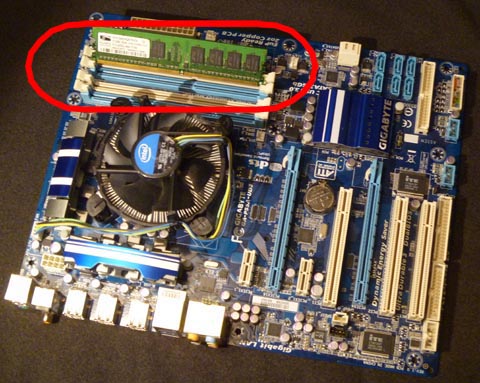
The motherboard of the computer is a printed circuit board; meaning it is an electronic assembly that holds integrated circuits and other electrical components that make up the computer, and connects them together electrically. The printed part means the electrical circuitry was acheived using printing techniques.
b) Central Processing Unit (CPU) - heart of the computer. This special integrated circuit holds millions of transistors!
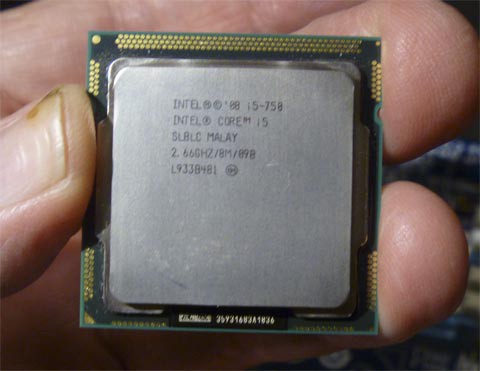
The Central Processing Unit (CPU) is the major integrated circuit on the motherboard. It is the brain of the computer and literally contains millions of transistors.
c) Random Access Memory (RAM) - temporary memory
RAM is supplied in the form of small daughterboards that are plugged into the motherboard.
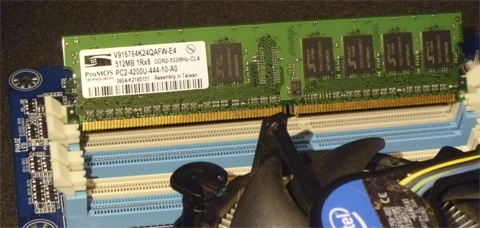
The idea of temporary memory is NOT something we humans normally think about. In actual fact, we use it all the time. When we wake up, we often lay in bed thinking about our day. Get the kids to school in time, stop at the grocery store for a few items we need for dinner, get home in time for our favorite TV show, etc. As each item is accomplished, we mentally check it off our list: it was temporary, now we can forget about it. The computer uses RAM (Random Access Memory) the same way. When power is OFF, the RAM has no power, therefore absolutely nothing memorized. Through the BOOT process, the computer copies various applications necessary to communicate with us from permanent storage. Once all the required applications are copied into RAM, the computer can present us with the familiar Desktop or the Start Screen.
d) Permanent Memory - Magnetic (Hard Drive) or electronic (Solid State Drive) permanent storage.
The traditional hard drive is the popular permanent storage device for most desktop and laptop computers. Similar to a phonograph record of ages past, a small metallic disc spins at roughly 5400 to 10 thousand revolutions per minute, and has a moving head assembly to read and write data using magnetic techniques. The moving parts are susceptible to failure. The probability of failure is one of the main reasons you should back up your data regularly.
In the following photograph, the larger unit is the standard size for desktops, the smaller is for laptops. They are built the same way.

Inside, (see photo below) you can see the metallic disc that spins at 5400 rpm or more, and stores your data. The structure that looks similar to the tone arm of a record player, has a similar function. Instead of a needle, this one holds the electro-magnetic heads that read and write magnetic fields on the spinning disc to read or record your data. Moving parts mean the drive WILL fail! We just don’t know when. That’s one of several reasons you must back up your data.
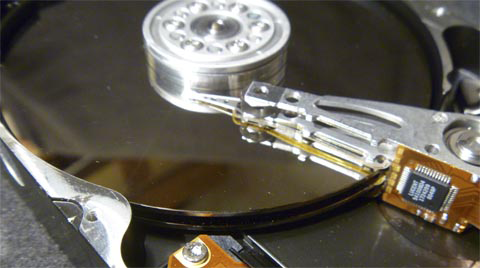
Solid State Drives have no moving parts, so are not prone to that type of failure.
e) Optical storage drive (CD or DVD). The disc placed in the drive is the actual memory. The combination of the disc and the drive makes the pair a memory device (or memory system).

The optical storage drive is a mechanism to read, and sometimes write, the information stored on an optical memory. The optical memories all resemble each other in shape (CD and DVD), but vary in capacity and technology. They are called optical because they are written and read using light (laser) and optical elements.
f) Power supply
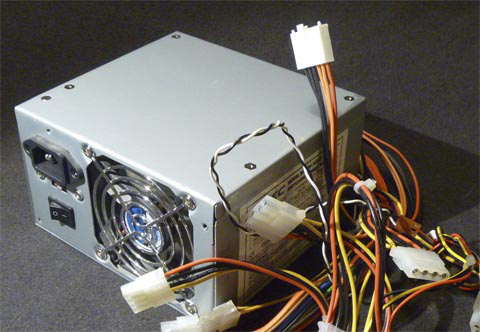
Integrated circuits that make up the computer cannot directly use the voltage and current supplied to our homes. The power supply converts that voltage and current into values that won't destroy the computer.
Laptop Charger
In the case of portable (battery operated) devices, such as cell phones, tablets and laptops, the small box that sits between house power and the device is not so much of a power supply as a battery charger! Portable devices are intended to be just that; portable. They run on battery power. The charger is connected only to charge the battery. Once the battery is charged, the charger should be removed.
NOTE: This is the physical part of the computer. Just as a house has individual parts (rooms, furnace, washer, dryer, stove, refrigerator) inputs (electricity, cable TV, telephone) and outputs (garbage, recycle, sewer etc.),., a house can NOT be a home without.....PEOPLE! People convert a house into a home.
It is the Operating System that converts a collection of electronic 'junk' into a useful tool.
4) The role of the Operating System
![]()
When you turn your computer ON, it is the operating system that assumes the roll of housekeeper in the computer. As such, it relieves you of the otherwise tedious business of properly loading all the software that allows you to work with your data/information. For the most part, you don't have to remember where applications are, what is necessary to allow you to print your information, how can the computer actually read drawings of any sort using a scanner, how it knows that the little chip I plug into the computer has photos and videos on it, and... The 'housekeeper' takes care of all of that. You just ask it to start your application and away you go!
When we use a computer application for anything related to collecting information from us, the application will save a digital copy of the information in permanent storage as an electronic file.
The Boot Process
EVERYTHING is in permanent storage until the computer is turned ON. When the computer boots (wakes up) it is like a newborn infant. It knows NOTHING! A read only memory (BIOS) contains the Basic Input/Output System code that 'teaches' the CPU how to read the operating system from whatever permanent storage device is available. The operating system is then loaded into the temporary memory (RAM). Only after the operating system completes the entire boot process, will the computer be ready to accept a command from its human.
To give you, the user, the freedom of NOT having to install new drivers for any device you add to your collection, todays operating systems are considered plug-and-play. Plug-and-play is just a way of saying the operating system includes all of the most common drivers for nearly any device you choose to add to your computer. HOWEVER; this also requires that the computer check EVERY possibility of your having changed the actual collection of electronic stuff that makes YOUR computer unique, while it was turned off! Thus the plug-and-play nature of your computer is part of why the computer takes so long to get to the desktop or start screen.
In Class 1, you learned the computer will start up faster by not actually turning the computer OFF! You can experience faster start up and shut down times by telling the computer to sleep rather than shut down.
Telling the computer to sleep is like telling a friend “I have to leave for a minute, but I’ll be right back”. When you wake the computer up (poke the power button), it is like you never left. The computer does NOT need to re-boot. It will return to the exact same thing you were doing when you told it to “Go to sleep!”.
5) Using Windows File Explorer, a File Manager
![]()
What is a File Manager? A file manager is a piece of software (or program) that allows you to, well, manage your files. You can create new folders anywhere on the computers' permanent memory you wish. You can move or copy files from one folder to another. You can also move or copy complete folders from one folder or memory device to another (floppy disc, flash drive, CD, DVD or external hard drive, etc). It makes no difference what is IN the file (or folder), they all behave the same way!
Windows File Explorer is the file manager application supplied with the Windows operating system (Finder is supplied with MAC computers). They are used to explore and manipulate the file system personal computers are based on.
The Windows File Explorer Window
By now you should be able to open the Windows File Explorer application. Most of the time the Windows 10 operating systems come with the Windows File Explorer icon (looks like a file folder) already 'pinned' to the task bar. Pinning is another useful term from everyday life that is now applied to computers. You 'pin' a note to a cork board to keep it handy, or apply a yellow sticky somewhere for the same reason! If the Windows File Explorer icon isn't pinned to your task bar, you can check the start screen, or search for it.
Look at the window that opens after you start the application. You should see several normal window components: Title bar at the top (notice that in this case, the title is NOT Windows Explorer, but the name of the folder selected in the navagation pane), Menu bar under the title bar, Tool bars or the more recent Ribbon, the Status bar at the bottom of the window.
In addition to the normal window components, you should see two window panes of information in the window workspace; the Navigation (Left) pane and the Content (Right) pane.
If you would like a printed copy of the File Explorer window, with all the important features labeled, check the Tips and Shortcuts page of this website. There you will find: File Explorer with Windows Properties.pdf. You may view it, and print it.
The File Explorer Navigation Pane
When you file something (save a file) in a computer, the container you file it in is a folder! The navigation pane of the file manager is where you find (navigate to) the folder (container) you put your file in. It is also where you create a NEW folder in what ever folder you select, more on that later.
The File Explorer Navigation Pane (left pane) has TWO click-able areas:
- 1) The arrow heads to the left of the folder icons.
- NOTE: Until you move your pointing device cursor into the Navigation pane, the arrows will NOT appear!
- 2) The folder titles.
Additionally, the Navigation Pane only shows how the folders are stacked; it does NOT show files! Like the Russian dolls, folders can hold folders that can hold folders...
1) When you click on the arrow head of a folder, you will tell the computer to OPEN or CLOSE the folder! The direction the arrow head is pointing tells you the OPEN (NOT toward the icon) or CLOSED (toward the icon) status of the folder.
Think about the idea of navigating a kitchen to find or place a recipe in a container. The containers we find in a kitchen can be a refrigerator, oven, canister set (for flour, salt, cookies, etc.), a cabinet or a box (like a recipe box). They all have an OPEN or CLOSED condition...just like a folder in a computer!
NOTE: only ONE way to open/close a container in a computer: many ways to open/close a container in a kitchen...vacuum sealed jars or cabinet doors, for instance!
The file manager is so useful in the computer, there are many times a dialog box will open to let you use your knowledge of the file manager to help you locate the container (folder) in which you will find the file you want to open; OR to help you find or create a container (folder) you wish to save a file in!
The File Explorer Content Pane
2) When you click on the title of a folder in the navigation pane, you tell the computer to show you the content of the folder in the Content pane (right hand pane) of the file manager window.
Information in the content pane displays both folders and files (if there are any), in the folder you select in the navigation pane. The FORM of the files and folders depends on the view (menu) you last selected!
NOTE: If your view of the content/details pane does NOT look like what you expected or prefer, remember to select the View menu, then select the layout you prefer.
Class Exercises
The Navigation pane (left 'pane' information) has TWO click-able items. In the navigation pane you should find titles of groups of information such as Network and most important for us, This PC. Move the cursor for your pointing device into this pane and observe a number of small arrow heads that appear to the left of the group titles. The arrow heads are the first click-able area.
To help explain a concept; beginning at the TOP of the Navigation pane, select EVERY arrow head that is NOT pointing directly at the icon to its right. When you are done, you will have very few lines remaining; including: >This Pc and >Network.
Now consider each line to represent file cabinets and the arrow heads to be the handles of the file cabinet drawer. If the handle points to the folder icon, the drawer is closed. If the handle does NOT point directly at the folder icon, the drawer is open and the names of any file folders in the drawer are listed in indented form below the name of the drawer. The drawer is opened and closed by selecting the arrow head (drawer handle).
At this point, the concept fails because no file drawer I know of contains more file drawers. However, the concept could continue if you think of a file drawer as being 'recursive' like the Russian dolls that have a doll inside a doll inside a doll, etc.
Navigation is the name given to the process of opening each drawer or file folder in the drawer to locate the specific folder you are looking for. Once you find the folder you are searching for, select the second click-able area, the NAME of the folder in the LEFT pane, to observe the folder contents in the RIGHT pane.
Special Note: You may find that clicking on the file or folder name may also serve to open or close the folder. However, and in my opinion, the significant 'flashing' of changing data in the content pane is a distraction you don't need when you are concentrating on finding a folder in the navigation pane. If the flashing does not bother you, go for it.
Storage Devices
Storage devices, in our digital world, are our File Cabinets. When we have one or more file cabinet(s), we need some way to differentiate between them. The operating system assigns a letter to each storage device on the computer in the order it finds them during the boot process. In particular, look for the (C:). This is the main permanent storage device for the computer. Letters are also assigned for each storage device you add via USB ports while using your computer. EVERY storage device on the computer will have a letter and colon, both in parentheses, as part of its label.
Personal Folder Shortcuts
Microsoft has chosen to display shortcuts to at least six special folders as part of This PC. The special folders are:
- Desktop
- Documents
- Downloads
- Music
- Pictures
- Videos
These folders are your personal folders on (C:) drive. They are part of the personalization of the computer, because if you have allowed other users to log into the computer using their own name, they will have their own set of folders with the same names. When we talk about keeping backups of your data, it is these special folders that are automatically saved for you (as well as those belonging to other users).
While you can create folders anywhere in the computer, it is recommended you create folders for any data you enter into the computer (and that you don’t want to lose!) in one of these special folders. When you choose to make use of the File History backup facility in Windows 10, these are the folders that will automatically be backed up.
6) Windows File Explorer functions
![]()
Any File Manager provides the following services:
A. Create a new folder (applications create files)
B. Rename a file or folder
C. Move or Copy a file or folder
D. Search for a file or folder
E. Open a file or folder
F. Delete a file or folder
A) - Create a new Folder
One of the most important things Windows File Explorer can do for you is create a new folder with your choice of name anywhere in storage. The most important thing to remember when working with a computer is to select WHAT you want to work with first. So, before telling the computer to create the new folder, you must tell it WHERE you want the new folder.
Experience in teaching these classes has made it obvious to me that people WILL forget to first select the folder they wish the new one to appear in. Therefore; I do NOT recommend you use the New Folder icon in the Ribbon of the Home menu tab.
So, to create a new folder where you want it: Navigate to, and context menu click the folder in which you want your new folder to appear (such as an album named Hawaii 2018 in the Pictures folder). Then, from the pop-up menu, select New, then Folder.
A text box appears with the words New Folder already highlighted. Hands OFF your pointing device! Just type the name you want the folder to have, AND THEN POKE ENTER to tell the computer you are done typing!
If you inadvertently clicked, or otherwise caused Windows File Explorer to accept New Folder as the name for your new folder, go on the the next section to rename the folder.
B) - Rename a File or Folder
Navigate to, and context menu click the folder (or file) of interest. Then, from the pop-up menu, select Rename.
A text box appears with the folder name already highlighted. Hands OFF your pointing device! Just type the name you want the folder to have, AND THEN POKE ENTER to tell the computer you are done typing!
C) - Move or Copy a File or Folder
Navigate to, and select the file or folder of interest. Keep pressing the pointing finger button and drag the item to its new location, paying attention to the words that appear under the item as you move it. Make sure it has you choice of action (move or copy) AND that it will go into the folder you think you are pointing to, then drop it (release the pointing device button)!
NOTE: If you drag and drop ON THE SAME MEMORY DEVICE! you will actually MOVE the file or folder! To force the computer to copy it, press and hold down the Ctrl key on your keyboard before dropping the item.
If you first select the item you want to move or copy, our keyboard shortcut friends CTRL+C (copy) and CTRL+V (paste) also work.
D) - Search for a File or Folder
If you are viewing either the actual Windows File Explorer window, or a printed copy of the File Explorer with Windows Properties pdf document on the Tips and Shortcuts page of our website; you should see two text boxes just under the ribbon near the top of the window. When you select a folder in the navigation pane, the local address of the folder appears in the first text box. The right hand text box should show the word Search, followed by the name of the folder you have selected. Anything you type in this text box will be searched for in the folder you have selected.
Your thought process should be: select the folder you think contains the folder or file you are searching for, then, in the text box with Search xxx, type all or part of the name as you remember it. The file manager will attempt to find any file or folder that has the information you have typed as all or part of the file or folder name. The results of the search will appear in the content pane.
When all else fails, use the (C:) line with whatever the folder name is, as the folder you choose. File Explorer will then search the entire permanent storage for the file or folder you are looking for.
5) - Open a File or Folder
It really doesn’t take the file manager to open a file or folder, but you usually are using the file manager to find the file or folder you want to open. Use the double click shortcut to open either one,
>> OR <<
Use your menu click to open the context menu and select Open!
6) - Delete a File or Folder
It really doesn’t take the file manager to delete a file or folder, but you usually are using the file manager to find the file or folder you want to delete. No matter where you find it, select it, then poke Delete on the keyboard.
>> OR <<
Menu click the file or folder, select Delete in the context menu.

